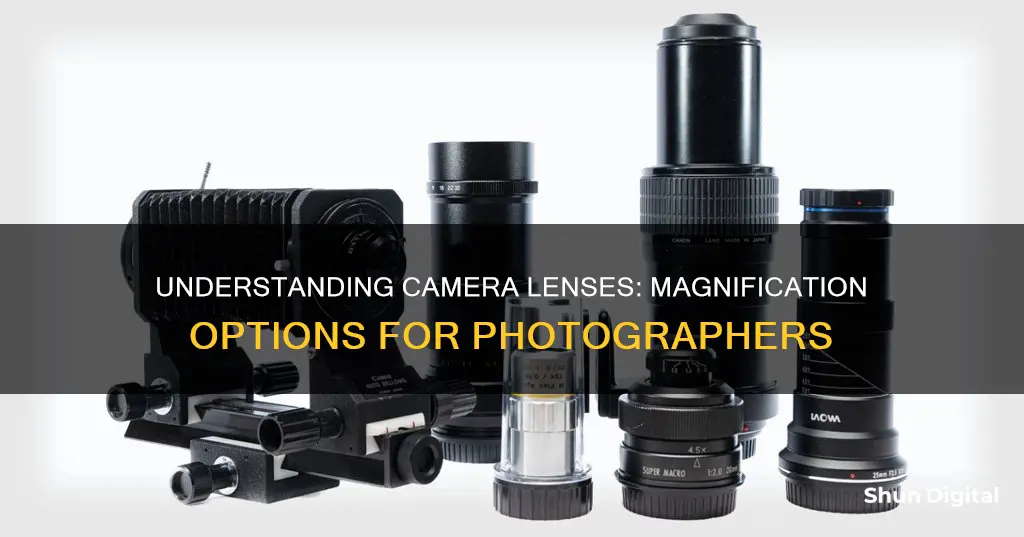
Camera lenses are measured in focal length, not magnification. Focal length is the distance from the lens's rear nodal point to the image plane inside the camera body. The longer the focal length, the greater the magnification of the lens will be.
Magnification, also known as reproduction ratio, is a property of a camera lens that describes how closely you've focused. It is the ratio between an object's size when projected on a camera sensor versus its size in the real world.
The magnification of a lens means how large or small a subject can be reproduced on the image plane. It is calculated by dividing the image length by the subject length.
The longer the focal length, the narrower the angle of view and the higher the magnification.
| Characteristics | Values |
|---|---|
| Description | Focal length |
| Calculation | Optical distance from the point where light rays converge to form a sharp image of an object to the digital sensor or 35mm film at the focal plane in the camera |
| Units | Millimetres (mm) |
| Types of lenses | Prime and zoom |
| Prime lenses | Fixed focal length |
| Zoom lenses | Variable focal length |
| Magnification | How large (or small) a subject can be reproduced on the image plane |
| Magnification calculation | Y/X, where Y is the image length and X is the subject length |
| Magnification representation | 1:2, or 0.5x |
| Magnification in viewfinders | Divide the focal length by 50 |
What You'll Learn
- Magnification is the ratio between an object's size when projected on a camera sensor and its size in the real world
- Focal length is the distance from the lens's rear nodal point to the image plane inside the camera body
- The longer the focal length, the greater the magnification of the lens
- Magnification is independent of the film frame size and sensor size
- Magnification is a property of the lens and the lens alone

Magnification is the ratio between an object's size when projected on a camera sensor and its size in the real world
Magnification is a property of a camera lens that describes how closely you've focused on an object. It is the ratio between an object's size when projected on a camera sensor and its size in the real world. This is usually written as a ratio, such as 1:2, which is said aloud as "one to two magnification".
For example, if you're doing macro photography and the object you're photographing has a projection on your camera sensor that is 1 inch across, and the object is 2 inches across in the real world, your magnification is 1:2. It doesn't matter what units of measurement you use, as long as you maintain the same units for both the projected and real-world size of the object.
Magnification can also be written in decimal format. For example, 1:2 magnification is equivalent to 0.5x magnification, found by dividing 1 by 2. This is how magnification usually appears in a list of a lens's specifications.
It's important to note that magnification is different from zoom range, which is the ratio between the longest and shortest focal lengths of a lens. For example, a Canon EF-S 17-85mm IS USM Lens has a 5x zoom range (85mm divided by 17mm).
The magnification of a lens also differs from viewfinder magnification, which refers to the subject size in the viewfinder. Viewfinder magnification varies across camera models and does not affect the final image.
It's worth mentioning that the focal length of a lens, typically represented in millimetres (mm), is not a measurement of the actual length of the lens. Instead, it describes the optical distance from the point where light rays converge to form a sharp image of an object to the digital sensor or film at the focal plane in the camera. The longer the focal length, the higher the magnification, and vice versa.
In conclusion, magnification is a crucial aspect of photography, especially in macro and close-up photography. It determines how closely you can focus on an object and how large it will appear in your image relative to its real-world size.
Unlocking the Secrets of Commercial Camera Lenses' Diffraction Limits
You may want to see also

Focal length is the distance from the lens's rear nodal point to the image plane inside the camera body
Focal length is a measure of how strongly an optical system converges or diverges light. In the case of camera lenses, it is the distance from the lens's rear nodal point to the image plane inside the camera body. The greater the focal length, the greater the magnification of the lens will be.
Focal length is not to be confused with focus distance, which is the distance from the lens to the subject. Focal length is also not the same as the field of view, although the two are related.
The focal length of a lens is defined by the thin lens equation:
> 1/f = 1/do + 1/di, where di = image distance = distance from lens to sensor, and do = object distance = distance from lens to subject.
When you change the object and image distances (do and di) to maintain focus, the focal length (f) normally stays constant.
In a simple axi-symmetric double convex lens, the focal length is measured from the optical centre (also called the geometric centre) of the lens. In more complex lenses, the reference point is the centre of a hypothetical single element with the same focal length.
The focal length of a lens determines the magnification at which it images distant objects. It is equal to the distance between the image plane and a pinhole that images distant objects the same size as the lens in question.
Camera lenses are measured in focal length, not magnification. However, it is very easy to convert the focal length of a camera lens into a binocular/scope-like magnification factor with simple math. On a full-frame digital or 35mm film camera, 1x magnification is achieved by using a 50mm lens. Therefore, to get the optics magnification factor, simply divide the focal length of the lens by 50.
So, for example, a 100mm lens is 2x, a 200mm lens is 4x, and so on.
Renting Camera Lenses: Best Places to Get Them
You may want to see also

The longer the focal length, the greater the magnification of the lens
The focal length of a lens is the distance between the lens's rear nodal point and the image plane inside the camera body. In other words, it is the distance between the plane of the sensor and the optical centre or nodal point of the lens. This determines the lens's angle of view.
The focal length of a lens is crucial because it determines the lens's field of view. The longer the focal length, the narrower the area of the scene captured by the lens. This means that a lens with a short focal length captures a much broader view than a telephoto lens.
For example, a 300mm lens has a magnification of 6x. This is calculated by dividing the focal length by 50 to get the magnification. Another way to calculate this is to divide the focal length by 100 and multiply by 2.
It's important to note that the focal length is not the same as the "x" value of a zoom lens. For example, a lens with a focal length of 17-85mm has a 5x zoom range, which is calculated by dividing the longest focal length (85mm) by the shortest focal length (17mm).
The focal length of a lens is a key specification to consider when choosing a lens for your camera. It determines what your camera can focus on and how your images will turn out.
Why Are Camera Lenses So Affordable?
You may want to see also

Magnification is independent of the film frame size and sensor size
Magnification is a property of a camera lens that describes how closely you've focused. It is the ratio between an object's size when projected on a camera sensor versus its size in the real world.
The magnification of a lens means how large or small a subject can be reproduced on the image plane. The definition of magnification is very simple. If a subject of length X forms an image of length Y in the image, the magnification of the lens is defined to be Y/X.
The closer you focus, the larger your magnification will be. Macro lenses routinely go to about 1:1 magnification, although some can only go to 1:2 magnification. A few specialty macro lenses can go beyond 1:1 magnification, such as the Laowa 100mm f/2.8, which can go to 2:1.
Magnification is usually written as a ratio, such as 1:2, which is said aloud as "one to two magnification". It can also be written in decimal format. For example, 1:2 magnification could be written as 0.5x magnification.
Calibrating Camera Lenses: The Ultimate Guide to Perfection
You may want to see also

Magnification is a property of the lens and the lens alone
Magnification is a property of a camera lens that describes how closely you've focused. It is the ratio between an object's size when projected on a camera sensor versus its size in the real world. This is usually written as a ratio, such as 1:2, which is said aloud as "one to two magnification".
The magnification of a lens is independent of the film frame size and sensor size since it is a lens characteristic. For example, the Nikon AF 60mm F2.8D Micro is capable of life-size magnification on a Nikon film camera. If this lens is used with an APS-size Nikon DSLR body, it will still deliver a life-size magnification.
Camera lenses are measured in focal length, not magnification. Focal length is the distance from the lens's rear nodal point to the image plane inside the camera body. The greater the focal length, the greater the magnification of the lens will be.
The only way to increase magnification without resorting to external accessories is to focus closer and closer (or buy a different lens).
To get the magnification value of a lens, divide the focal length by 50.
Recognizing Camera Lenses: A Beginner's Guide to Identification
You may want to see also
Frequently asked questions
Magnification, also known as reproduction ratio, is a property of a camera lens that describes how closely you've focused on an object. It is the ratio between the size of an object in the real world and its size when projected onto a camera sensor.
Magnification is usually written as a ratio, such as 1:2, which is read as "one to two magnification." It can also be written in decimal form, such as 0.5x for 1:2 magnification.
Magnification is a property of the lens itself and does not change with sensor size. However, using a crop sensor camera can make your subject appear larger in the final image, even though the magnification remains the same.
To calculate magnification, divide the size of the object's projection on the camera sensor by the size of the object in the real world. For example, if an object 2 inches long is projected as 1 inch on the sensor, the magnification is 1:2 or 0.5x.
You can increase magnification by focusing closer or by using accessories like extension tubes, reverse lens adapters, close-up filters, or teleconverters. Additionally, switching to a lens with a longer focal length will provide higher magnification.







